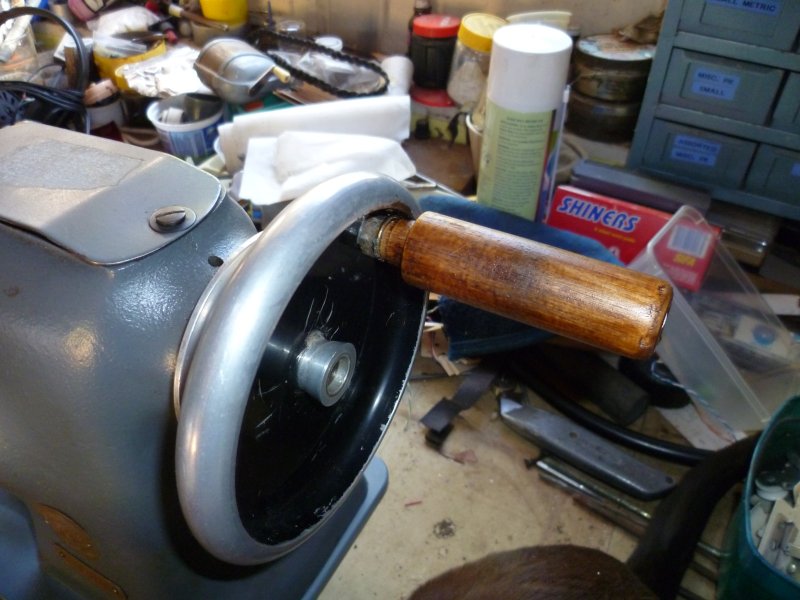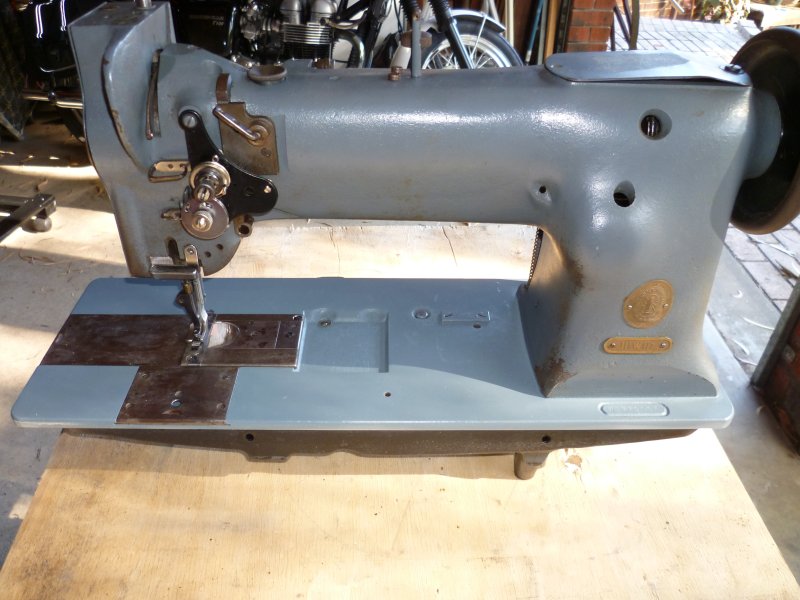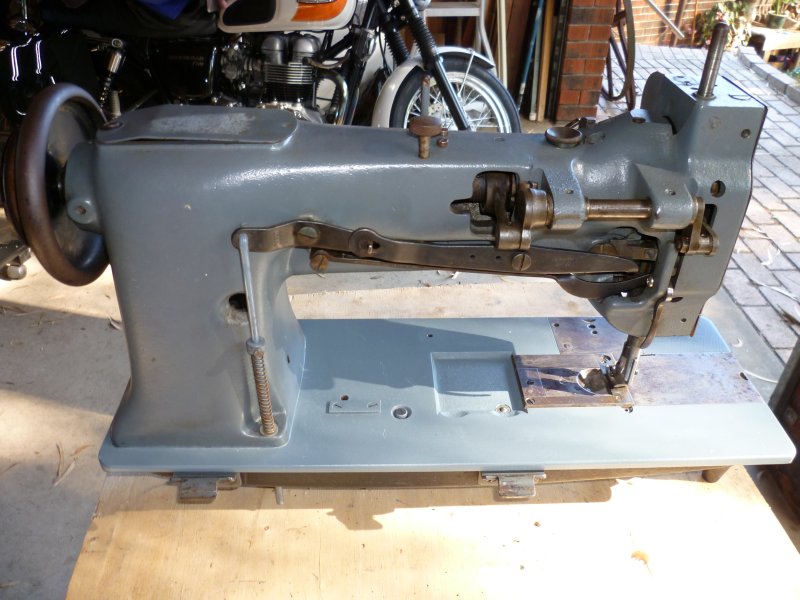-
Posts
4,808 -
Joined
-
Last visited
Content Type
Profiles
Forums
Events
Blogs
Gallery
Everything posted by dikman
-
Ok, I see what you're talking about. Yep, using a knee/foot lift will let you get thicker stuff under the feet but I think there would still be problems with the feet being able to feed the leather properly. Of course, I could be wrong here as I haven't experimented that much with it, I've learned to keep my machines pretty much within the range they were designed for (I don't need to create any more problems than necessary!!). Actually, I haven't used my 211 much as I've found that the 111WSV77 has a longer stitch length and seems able to punch through a bit better (although the 211 was a bit smoother to use).
-

"Hunter" knife and sheath
dikman replied to pzarkov's topic in Gun Holsters, Rifle Slings and Knife Sheathes
I'm not a fan of basketweave, but your stuff is very sharply defined! -

A Holster and belt
dikman replied to OLDNSLOW's topic in Gun Holsters, Rifle Slings and Knife Sheathes
Sorry, I guess being a Pom raised in Oz might account for the spelling mistake . (Maybe I was subconsciously thinking of the Purdy shotgun...). -
Jim, I think you'll find that on most machines (certainly all that I've come across) the foot-operated lift is always higher than the hand lever, otherwise you wouldn't be able to release the raised feet by using the foot pedal. I tweaked my 111 to try and get that extra clearance under the feet but it then meant that the feet didn't touch the feed dog on the down-stroke. This was ok as long as I used thick leather, but this also affected the clearance needed by the feet when moving back and forth. I didn't persevere with it.
-
I couldn't find a manual for this model, but found an earlier post about it - I assume you want to increase the lift height and clearance under the presser foot? If so, it can be done by tweaking the adjustments for the two feet, but it can take a bit of fiddling to get it right and the feet may not end up touching the feed dog plate. My experience with my 111's has been that it doesn't gain a lot by doing it, plus if you try to run leather through that is too thick for what the machine was designed for you may end up with other issues. The maximum stitch length is determined by the mechanical design of the particular machine. While theoretically it may be possible to change the stitch length by swapping out parts from another 111 model it's not something I would recommend trying - it's a big job, and not for the faint-hearted. Just enjoy the machine for what it is, the 111's are a wonderful, solid design.
-

Singer thread tension slide - part #264527
dikman replied to dikman's topic in Leather Sewing Machines
Lots of time on Google has come up with several part numbers for the same thing. Singer 264527 - fits my 117 and 153W103 Singer 240500 - fits 111W154/155 Consew/Seiko 10546 - 206B Juki B-1461-053-0A0 - Lu 562/563 Hopefully the industrial machine place in town can get one of them! -
Dorothy, it's obvious that you're starting from scratch regarding industrial machines (that was me a couple of years ago!) and there's a lot to learn. If you haven't done so already, read the stickies above (particularly Wiz's about leather machines) as it might help to understand the terminology a bit. I can only urge you to talk to Rocky, his kind offer to talk to you will save you a lot of time in coming to grips with this subject, and his experience would be hard to put a price on. In short, a clutch motor has always been the "standard" for industrial machines, they are fast (which is what's normally needed for commercial use) and can take a lot of practice to master. Most leatherworkers need the machine to go slow, which can be done with a clutch motor but requires a delicate touch (I couldn't do it!). A servo motor is an electronically controlled replacement motor that allows very slow speed control and requires very little time to learn to use. There is usually no one machine that can sew everything unfortunately. If a machine is designed for heavy (thick) leather it can be tricky to sew lighter stuff. If it can sew light to medium leather then it won't do heavy/thick stuff. This is why it's important to know exactly what it is you want to sew. Another "complication" is thread thickness. If you want to sew similar thread size to that used in hand stitching you need a big, heavy duty machine! You may have to change your ideas slightly about thread thickness if you want to use a machine for your work. The most commonly used thread sizes are #69/Metric 40 and #138/Metric 20. Once you start going bigger you need the bigger machines, plus the bigger threads can be hard to find here in Oz. It might seem a bit daunting at first but don't get discouraged, if you can determine which machine is going to fill your needs it will speed up your production significantly.
-
The previous owner had fitted a wooden handle to the handwheel (handle was too small and a very rough job of fitting it!). I made a bigger handle and used the vertical mill to get the handle to sit square to the wheel. This at least let me try running some thread through it. I had to drop the needle bar so that the hook could grab the bobbin thread but then worked fine and it ran some stitches in a piece of 5 oz. leather. It's going to need some adjusting though as it wasn't happy with a piece of 8 oz. (Using #69 thread and size 19 needle). I'm now thinking that maybe I'll make a small box frame to fit the base (like the old domestic Singer's had). This will make it a "portable" machine, inasmuch as portable means it can be moved - it's still bloody heavy - but I have to get the thread release sorted, it's pretty hopeless without it!
-

A Holster and belt
dikman replied to OLDNSLOW's topic in Gun Holsters, Rifle Slings and Knife Sheathes
-

My attempt at a Slim Jim
dikman replied to Mark Peters's topic in Gun Holsters, Rifle Slings and Knife Sheathes
Now that's different (bit like a modern art design on an olde-style holster). Looks good. -

A Holster and belt
dikman replied to OLDNSLOW's topic in Gun Holsters, Rifle Slings and Knife Sheathes
Mighty purty.....(to use a US colloquialism). -
There you go, Dorothy, talking to Rocky will be of immense value and could save you from buying the wrong thing and hopefully make sure you get the right machine for your needs.
-
Sounds a bit on the high side price-wise (to me, at least), given that it's not even a walking foot (probably asking a lot because of its age, I guess). From the little I could find out about this model it should do what you want, but bear in mind it has a clutch motor and for someone new to industrial machines they can be pretty scary, particularly when you want to sew very slow. I wouldn't mind it myself, only for what it is, but there's no way I'd pay that much for it. I think you'd be better off looking around a bit more and perhaps trying to find a walking foot machine, and if it doesn't have a servo motor then allow for that in the budget too. I reckon you should be able to find better value than that. Have a read of the "stickies" at the top of this section, they should help you to understand these machines a bit more.
-

Singer thread tension slide - part #264527
dikman replied to dikman's topic in Leather Sewing Machines
An interesting story, must have been quite a collection you ended up with. I guess if you ever get bored then sorting and selling them will give you something to do . I should clarify regarding your offer to help me. I've found in the past that some places in the US aren't interested in shipping to Aus, some won't take an Aus credit card (even to ship within the US) and many put ridiculous shipping prices on, presumably to deter buyers. This is why I buy much of my stuff out of China and Hong Kong - prices are good, they take Paypal and Aus credit cards and shipping is generally included, just makes my life easier. This, by the way, is how I got into leatherwork. I needed a particular holster, and I had so much trouble trying to get what I wanted out of the US that I decided to make my own - and now this leatherwork thing is all getting a bit out-of-control!! -

Singer thread tension slide - part #264527
dikman replied to dikman's topic in Leather Sewing Machines
You reckon you've got a W117 in your group? Quite a coincidence, as until I asked about it I couldn't find any mention of that model on the forum. They would appear to be somewhat uncommon, and, in my opinion, pretty useless as they come in standard form!! -
It's cleaned up fairly well. The gray paint on the base is a fraction lighter in colour but close enough (it came from my modelling stuff - I used to make plastic kits) - and is an old Humbrol paint. My airbrush tip is just a little too fine for something this large but it was better than using a bigger spray gun. The metal plates around the needle area were rubbed down with fine wet and dry paper to remove most of the rust, then rubbed with steel wool and coated with a heavy wax. I figure the chances of getting replacement plates for this slightly weird beastie is probably nil and Buckley's so they'll have to do. Now all I need is the tension release slide mentioned in my other thread. Everything else appears to be in pretty good shape internally. I'm toying with the idea of finding/making a suitable handwheel and fitting a handle to turn it into a handcrank machine. It also looks like it might handle #138 thread - maybe.
-

Singer thread tension slide - part #264527
dikman replied to dikman's topic in Leather Sewing Machines
Gregg, thanks for doing the detective work! I knew this particular model has an "automatic tension release", but couldn't figure out how it worked ('cos mine's missing the factory one but had a homemade version fitted). I also wondered about that big arm coming down from the top, now I know what it's for and how it worked! An unusual machine, to say the least. As for the internal release parts, I had already noticed, in the parts list, that these parts aren't fitted to the 117 but are fitted to the 116. I'm making an assumption here that being a 111 class machine there is going to be a commonality of design and parts fitting in many cases. I've already removed all the presser foot pieces and from what I can tell that missing piece should just drop straight in. At the moment the only way to release the thread tension is to push down on the arm at the back that goes to the knee lift linkage. Kellyblues, thanks for the kind offer, I'll keep it as a last resort (my past experience at doing it that way has had "difficulties"). -
ZigZag beat me to it! Here in li'l old Adelaide pure wool felt is very hard to find, every haberdashery/millinery/material shop I went to had felt, yes, but it's all synthetic stuff! One possible (cheap) source is second-hand shops, if you can pick up an old felt hat it may be usable (that's what I did).
-

Singer thread tension slide - part #264527
dikman replied to dikman's topic in Leather Sewing Machines
I think it is, I'll send him an email. -

Singer thread tension slide - part #264527
dikman replied to dikman's topic in Leather Sewing Machines
Saw that one, unfortunately he (she?) doesn't ship to Australia! -
Can't find one. I just spent the better part of a day trying to get my 111W117 thread tension disc to release - the 117 doesn't come with a "normal" tension setup as it has an "automatic tension release" (whatever that is). I fitted a standard tension assembly but after fitting a suitable pin I found that every time the foot lifted during normal operation it released the tension disc!! Eventually, after viewing one of Uwe's excellent videos I realised this part was missing - 'cos it isn't fitted on this model!! Anyone know of a source (preferably cheap) for this part? If not I'll have to make one, I guess. Other than this bit the rest of it appears to be in pretty good condition and looks like it's basically an early version of a 111W152/153.
-

"American" big iron machine - anyone ever seen one of these?
dikman replied to Cantab91's topic in Leather Sewing Machines
Yup, should never have got this far and is most disappointing. -

"American" big iron machine - anyone ever seen one of these?
dikman replied to Cantab91's topic in Leather Sewing Machines
Or an anchor for a big ship....... -

"American" big iron machine - anyone ever seen one of these?
dikman replied to Cantab91's topic in Leather Sewing Machines
Make sure your living room has a concrete floor!! -
That big lever below the stitch adjuster wheel, just push it down (same as most lever-operated reverse).





